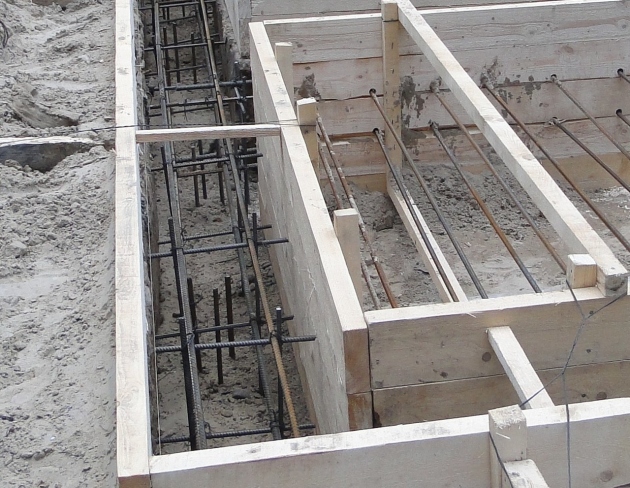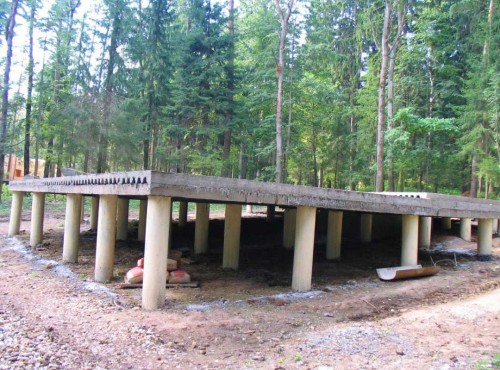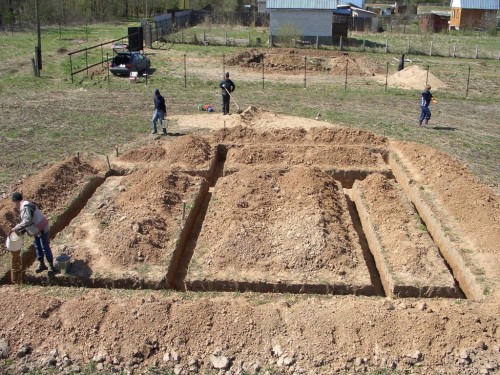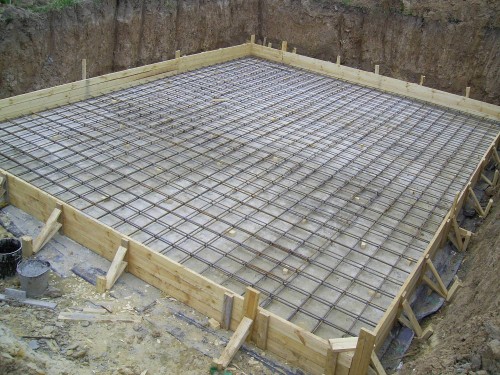First of all, it is worth knowing that any construction has its own characteristics, advantages and disadvantages. First of all, when construction is organized, the soil properties should be analyzed. It all depends on the existing location. In some places, the ground can be rocky, and in some - clay. Do not think that certain soils mean the impossibility of carrying out full-fledged construction work. It should only be understood that in some cases it is necessary to thoroughly prepare so that the structure is distinguished by high reliability and durability.
In this material we will talk about how the construction of a foundation based on sandy soil occurs. First of all, it should be noted that this task is not easy, as sandy soil changes its condition all the time. In hot weather, the soil is loose, and after the rain it becomes plastic. Accordingly, you need to be prepared for the fact that such a base has not the most pleasant features. Despite this, the soil may differ in many other aspects that we will talk about.
Also in the article we will try to analyze all the main problems and tricks associated with the creation of a foundation based on sand.
Features of sandy soil
If we are dealing with large construction (residential building, or a country structure), it is necessary to pay attention to the soil analysis. For this, there are special services, they conduct detailed research and draw conclusions that will definitely use the construction.
There is a huge number of real stories in which the soil analysis indicated that on an existing basis, the construction is unsafe. Well, if we are talking about small buildings, which may not be influenced by the soil shortcomings, however, large structures during operation can begin to give cracks, and also cannot be excluded for the appearance of the foundation deformations.
Accordingly, draw conclusions about construction should only after careful analysis.
If it is established that we have sandy soil, then this is not all the necessary information. This type of soil has as many as five species, and they all differ in the fraction of sand.
- Gravelish sandy ground. This primer has more than a quarter of the sand particles whose sizes can exceed 2 mm. It should be borne in mind that this is the most stable foundation for the arrangement of the foundation of a residential building.
- Middle ground soil. In this case, most of the sand particles are of size from 0.25 mm to 0.5 mm. Such a base is also not bad for construction work, as the soil has a high bearing capacity.
- Small sandy ground. Such a soil can consist of 75% of sand, the dimensions of the particles of which do not exceed 0.1 mm. The weak side of this foundation is the impossibility of holding moisture, therefore additional measures will be required that enhances the waterproofing of the base.
- Dusty sandy soil. This is exactly the natural basis to avoid all builders. The thing is that the carrier's ability of such a soil depends directly from the humidity, so its condition will constantly change. In this case, the particle sizes may not exceed 0.1 mm.
Main parts of the carrying capacity of the soil
Obviously, it is the carrying ability of the soil that is the most important characteristic for construction work. In the case of sandy soils, much in this indicator depends on the humidity. Accordingly, the more denser it turns out the soil, the larger loads it withstands.
Also, you should not ignore the information that too much water in the ground is a serious problem. In this case, we are again dealing with a decrease in the bearing ability of the soil. Therefore, there must be a certain balance in which the soil remains in one state for a long period of time (average humidity).
In addition, it is necessary to consider the features of the deepening of the foundation. The deeper the soil is, the stronger its compression resistance. Thus, if the soil matches all building requirements, the foundation can not be very deepened. At the same time, it still makes sense to think about sufficient deepening so that no problems arose during operation.
Waterproofing foundation on sand
The question of waterproofing in this case is more than ever. As we mentioned earlier, the sandy soil can become a source of high humidity, therefore the foundation should be submitted in advance waterproofing. It is worth knowing that this is the most important question, since the integrity of the entire structure depends on the state of the foundation. If the moisture all the time influences the unprotected foundation, he will quickly come into disrepair.
Most often used 2 receptions to prevent the negative impact of moisture:
- Creating a waterproofing layer. In this case, various rolled materials, or mastics, which are protected by the entire area of \u200b\u200bthe base can be used. If everything is done qualitatively, the moisture will unambiguously have no chance.
- Use of various components to create a concrete mix. In the process of construction, some building components can be used, which will not allow moisture to adversely to work. It is possible to experiment with various grades of cement, add one or other chemicals, as well as to use many other tricks. Similar ventures are better to organize together with specialists who will analyze the soil, as well as provide some information about possible risks.
Waterproofing materials
It makes sense in advance to note that dozens of materials can be used for waterproofing the foundation, which are characterized by high quality. However, do not forget that quite quickly all these construction resources may be disretened to the most diverse reasons. This suggests that it should be regularly checking the condition of waterproofing, otherwise at one moment we can face too serious problems. Even in a short period of time, the lack of material can seriously affect the state of the base.
- Harvest materials. These are rolled or leaf waterproofing resources that are often distinguished by a high level of protection. Earthwork materials are applied using a gas burner, but there are other application scenarios. This is the easiest option for beginners who do not have sufficient experience to carry out similar works.
- Plaster resources. Most often we are talking about plaster, in which there are some water-repellent additives. If the mixture used is really distinguished by high quality, it will protect the foundation from moisture for long years. As in the last case, the mixture to the surface will be easy.
- Fooling materials. Such resources are a variety of masses, emulsions, as well as viscous solutions. Such materials are applied using sprayers, brushes and spatulas - it all depends on the viscosity of the resource. Experts argue that it is this option for waterproofing that is characterized by maximum efficiency and durability.
Waterproofing process
Of course, the waterproofing component of the foundation is best to create even during the construction of the structure. Otherwise, numerous problems may occur.
The waterproofing process should be started only when it passed about a month after the fill of the concrete. Accordingly, it is necessary to create a small trench around the perimeter of the structure. The width of the trench should be about one meter. The depth of this element often exceeds 0.5 meters the height of the base. All this is done in order to create the most efficient drainage system.
Next, it is necessary to analyze the state of the foundation. If the foundation was recently erected, then his condition is probably excellent. However, it is impossible to exclude that in the process of operation, the base has gained numerous flaws, including quiet and cracks. From all this you need to get rid of it, so you need to use the grout (cement M-100 or higher cement), and update the surfaces.
The upper horizontal part of the base experts are recommended to be covered with two layers of rubberoid.
Separately, I would like to note that there are a lot of questions from those owners who decided to build a boronobibal or column foundation. In such cases, it should be borne in mind that waterproof the piles themselves is not necessary. It is necessary in those places where the base of the base soles is planned, placing polyethylene bags. Accordingly, the bags are glued to the surfaces of the pipes (pillars), thereby creating reliable protection against moisture and water. Directly on concrete pillars can be placed a bicrost layer, which will also create protection against moisture. You can still lubricate the pillars bitumen, but it is necessary to do it as much as possible. It is worth it in advance that the columnar foundations may quickly lose their strength (if small errors are made during construction), so it is necessary to isolate the base professionally. It will also be superfluous to check the status of the foundation.
Types of foundations for sandy soil
- Stroll or pile foundations. Such grounds, as already mentioned, are distinguished by high strength, as well as good durability. It should be borne in mind that most often such bases are chosen to build relatively small structures. Accordingly, if it is necessary to strengthen the foundation, it will be necessary to raise the main structure of the house above the soil. Also, do not forget that gradually the foundation pillars can shift slightly, which can lead to deformation of the whole structure. This is especially often under the influence of groundwater. If the formation technology is fully observed, then such a base will serve for a very long time, and the problematic soil will not be a hindrance.
- Slab foundation. It is worth recognizing that it is a slab foundation that is the most impeccable foundation for a private house created on the sandy soil. At the same time, it is worth paying attention to the fact that with due waterproofing, no drop of water becomes a threat to housing. But at the same time it is impossible not to note that the slab foundation is the most expensive pleasure for the owners. It will indeed be much cheaper to make a choice in favor of a columnar base, and there are still enough to be saved for repair work and waterproofing.
- Fine breeding ribbon foundation. Such a foundation is characterized by a rather modest price, and also has many advantages in terms of waterproofing events. At the same time, it becomes from the name that such a type of foundation cannot have a basement. As for the pros, this reason is often built on the basis of concrete blocks, and this is a significant savings. On the sandy soil, a small-breeding foundation will be distinguished, but this, first of all, concerns small-scale structures.
- Outlined belt foundation. In this case, we exclude all the flaws that are found at the base in the past paragraph. Accordingly, here we can have a full-fledged basement, but at the same time the need for a drainage system appears. At the same time, experts advise to carry out waterproofing the floor and walls of the underground room.
Determining the properties of soil
As we have already told, it is best to use the services of specialists to complete the soil. In the event that you are confident in your abilities, you should know something. The thing is that the sandy soil is often inhomogeneous, therefore to determine the nature of the soil, the shurts should be punctured (for a depth of about 2 m), and already make reasonable conclusions based on a full inspection. Such a simple procedure has been saved by the owners from incorrect actions.


















 Start a discussion ...
Start a discussion ...